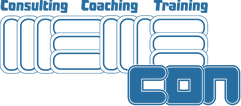Review the system
System durchdenken
We should always be aware that we can only process seven-plus-minus-two chunks. Simple processes can be refined by gathering experience, learning from it, and ultimately applying that knowledge to achieve success. Systemically, the whole thing becomes clearer, and more effective measures emerge.
In the following, we use the Resistance system to visualize the procedure.
Focusing
When describing a system, topic-oriented maps are developed that represent the knowledge of those involved in the system. To think through a system, the focus is on key aspects, such as organization, selected system components, and the effect of these components on the overall flow.Organization
The affected areas in the organization create an overview of the roles involved. For this purpose, they are selected and structured in a hierarchical and process-oriented manner.
Role
Our example focuses on change and the resulting resistance. The most significant pressure to change comes from IT components that permeate all areas of the company. For those affected, this means they must rethink and redo a considerable amount of work. The roles involved are consolidated and condensed into a manageable number.
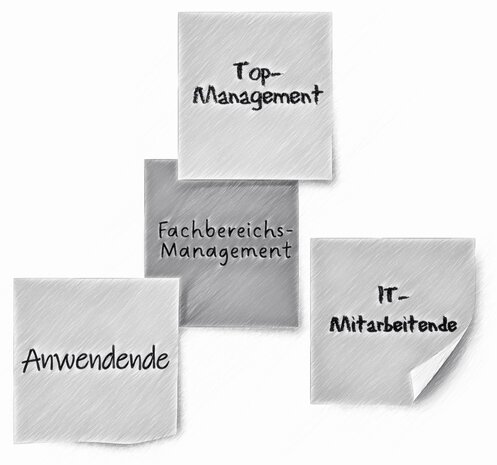
Role | Description |
| IT emploees | The role of an IT employee in introducing an IT system includes technical planning, implementation, and integration of the system into the existing IT landscape. They analyze requirements, manage configuration, conduct tests, and ensure technical quality. They are authorized to make technical decisions and are responsible for implementing a secure and functional system in compliance with standards, deadlines, and data protection requirements. |
| Users | When introducing a new IT system, users should adapt to the system effectively in their day-to-day work, participate in training and testing, and provide constructive feedback and reports of any malfunctions. They are authorized to use the system, make suggestions for improvements, and participate in training and tests. They are responsible for entering data accurately, adhering to guidelines, and supporting the change process with openness and active participation. |
Department management | The role of department management is to oversee a
specific function within the company and to manage change effectively. They
have decision-making authority in their area, are involved in strategic
decisions, control technical processes, and are authorized to issue
instructions. They are responsible for successfully implementing changes in
their area, promoting the willingness to change, as well as ensuring strategy
fit, efficient target achievement, and sustainability. |
| Top Management | The role of departmental management is to shape the
strategic direction of their function, communicate it, provide resources, plan,
manage, and promote change management, and evaluate the results. They are
authorized to shape the strategy, organize and coordinate cross-functionally,
and allocate the budget. They are responsible for strategy, corporate culture,
and sustainable results. |
Similar roles can be used simultaneously in different functional areas. For example, management roles serve the same purpose but in other functions. Controllers oversee key performance indicators, which can vary slightly depending on the topic area.
Hierarchical structure
All types of organizational structures are possible: line, matrix, network, and new ones like holacracy or humanocracy. Typically, there should be documentation highlighting the affected areas. If not, it's time to create this map.
The hierarchical structure allows you to define the organizational scope.
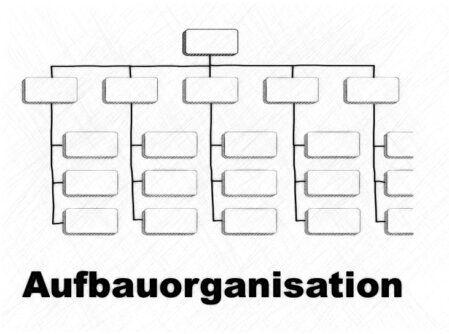
Process organization
The processes can be described with a process map, a customer journey, SIPOCs, or other procedural diagrams, as long as the depictions are printable.
Additionally, in hierarchical structures, the organizational scope can be demonstrated.
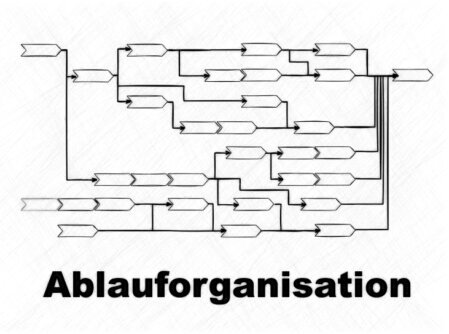
System net
The system net represents the system elements and
relationships in a "map". To develop it, the building blocks must be
identified.
Elements
When examining the Resistance system, the components
related to resistance are brainstormed, then bundled, and prioritized. It leaves seven-plus-minus-two elements.
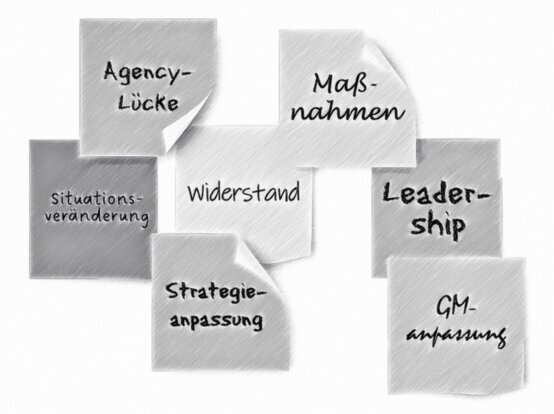
| Elements/ System components | Description |
Agency gap | Changes in self-image, business model, and
strategy challenge the power to act. Everyone is affected differently. As
soon as the new situation does not match the self-image of the
exec(utives/utors) and their interpretation of the role, an agency gap arises
that creates personal
stress. |
| Resistance | Resistance arises from not knowing, not being able, not being allowed,
and not wanting. |
Measures | Measures to reduce resistance are: publishing, training, permitting, and
convincing. |
Strategy adjustment | The strategy comprises the Vision, Mission, Critical Success Factors, Value
disciplines, SWOT, Strategic orientation, strategic goals, and the Strategic
core. |
| Self-image adjustment | The
self-image (or identity) encompasses context, actions, abilities, beliefs,
roles, and affiliation. |
| Business model adjustment | Changes in
the business model encompass the Deliverables concept, Earning model, Value
creation, partners, organization, customers, resources, communication, and
coordination. |
Guidance | Leadership involves setting goals, maintaining transparency, organizing,
making decisions, managing, developing, and fostering people. It is the primary task of leaders. |
Change of situation | The situation is the overall picture of self-image, business model, and
strategy. |
Relationships
A system begins to "live" as soon as its
elements are connected and fulfill their cycles. The states of all elements are
determined by initiating elements (causes) and subsequent elements (effects).
Once the system network is "woven" and "running", cycles
can be identified.
Causes are reasons, occasions, and conditions that influence one or more elements. These prerequisites are addressed by the question: What inputs/conditions does an element require? This is an agency gap, i.e., the challenges to agency that trigger personal stress and, subsequently, resistance among those implementing it when changes occur in self-image, GM, and strategy. In the image, the plus sign symbolizes that an
increasing agency gap increases resistance.
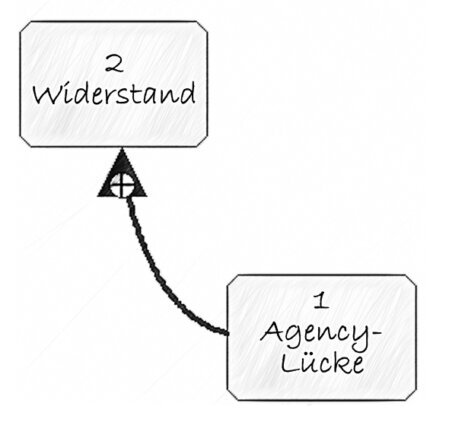
Effects are implications that are passed on from one element to another. The elements to be supplied are identified by the question: Which outputs or effects influence which elements? Increasing change in the situation (e.g., additional actions required in the identity, business model, or strategy) increases the need for leadership, for example, to create transparency, set goals, and make decisions.
In the example, the change in the situation increases
management activities, which in turn eases the issues. This interaction
prevents uncontrollable escalation.
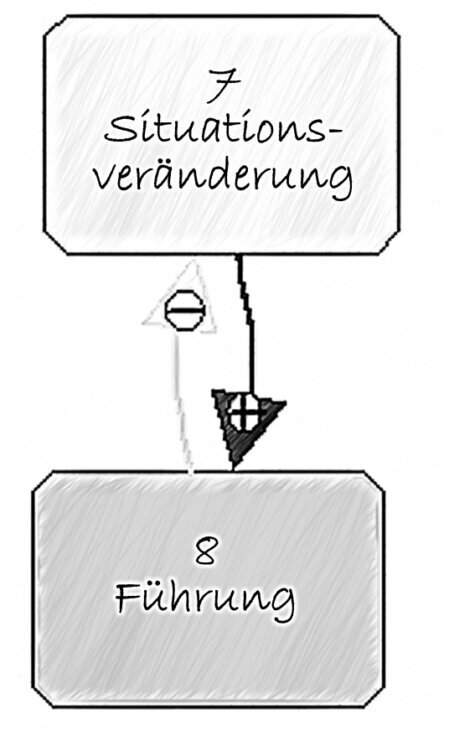
Cycles become visible when many elements are described
in terms of their correlation with one another. In the simple case, between two
elements (see effects) or across several elements. The situational change
affects the agency gap, which in turn influences the participants' resistance,
and this resistance affects the situational change. This cycle escalates
through a continued self-reinforcement of its elements until it collapses. In
the example, leadership intervenes to prevent escalation (see consequences). If
the changes recede, the elements calm down, which means that all parties
involved are in control of the situation and have no reason to resist.
The solution to this cycle can be found in the overall system, where the self-reinforcing cycle is interrupted by leadership (see effects).
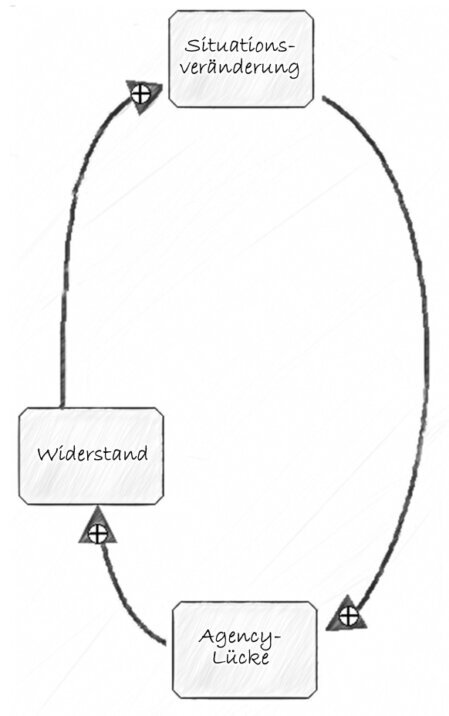
Map
The complete interplay quickly becomes unmanageable.
Visualization makes it easier to understand system dependencies and to
recognize patterns.

The image provides an overview for critical review.
Critical consideration
The prerequisites for overcoming problems are
- The conscious use of their metaprograms,
- The adoption of different standpoints and
- The positive orientation of the mindset towards the solution.
Consider metaprograms
Metaprograms are filters, patterns, and conclusions
that shape our perceptions and understanding of the world. They influence
perception, thought processes, and behavior. The following metaprograms are
examples.
- The worldview is determined by the general complexity and size of the chunks (the bundling of information into meaningful units), as well as the linear or systemic nature of the worldview.
- The directions are top-down or bottom-up, away from or towards, systematic or intuitive.
- The organization consists of management, control, structure, and process styles.
- The attitude distinguishes between high-context and low-context communication, as well as behavior and thinking styles.
- The time aspects consist of the time horizon (past, present, or future), time orientation (long-term, medium-term, or short-term), and time experience (in-time or through-time).
It is essential to be aware of your own biases and
prejudices to minimize drawing false conclusions. Exchanging metaprograms facilitates the
discussion, enabling participants to identify gaps and agree on a joint
perspective.
Change vantage point
Insights are determined by the system context and the
vantage points we use. A single perspective acts like a pair of blinders. We only see where our
attention takes us. Even a simple turn of the head provides new
insights. If we also change our spot, completely new circumstances emerge. We move within a 3D-Action-Frame by using different
perspectives or by assuming specific roles.
3D-Action-Frame
Changes always occur in three dimensions: spatial, temporal, and topical. The space is accessible from different local perspectives: from above, from below, from a distance, or in the midst of the action. Time takes us back to the situations we have experienced, into the future with current expectations, or allows us to observe what is currently happening. Topics arise from the subject areas, characteristics, or circumstances.
By changing the observation post, we gain more insights. Each insight has its defined context in the 3D-Action-Frame and leads to alternative facts.
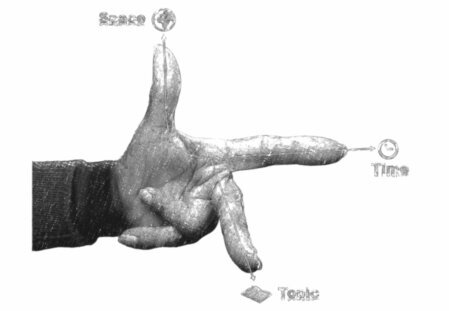
Perspectives
Perspectives filter certain aspects from the flood of
particularities. It enables us to grasp and assess a situation in a refined
manner. Perspectives encompass emotional, analytical, hopeful, critical,
creative, and integrative points of view.
The emotional view, for example,
highlights both pleasant and unpleasant sensations (e.g., joy, excitement,
aversion, and fear). Or the analytical view that ensures
logical consistency with its structure and logical considerations of the
context (Where?), the period (When?), the participants (Who?), the activities
(What?), the resources (With what?), and the beliefs (Why?). Changes in
perspective prevent a one-sided look at circumstances.
Perceptual positions
It makes a big difference with which role we look at
the circumstances. When we are the main character in a situation, we experience
it differently, as if we were looking at it from the outside.
- In the first position (I), we are bound by our mental states, beliefs, and experiences.
- In the second position (You), we examine the first position with our assumptions and suppositions as a counterpart.
- In the third position (Meta), we are outside of the situation and take a neutral view of what is happening.
The change of perceptual
positions enriches the description of the situation.
Check the mindset
Systems thinkers are aware that beliefs and attitudes
regarding control systems, cooperation, and creativity influence their view of
system behaviors.
Control system
The control system comprises a set of beliefs about
what is right and wrong, as well as what is true and false. It is a subjective
attitude that involves holding a particular stance, perspective, or opinion
about something. These aspects include principles, values, norms, and
prejudices.
Cooperation
The collaborative configuration is characterized by
the ability to recognize and understand the benefits of collective work and diverse
perspectives. The development of a joint mindset is fostered by the general
desire to learn from one another. Key aspects include group-based
communication, collaboration, networking, and active participation.
Creativity
Attitudes and behaviors define creative practice.
These include curiosity, the ability to suppress judgment, tolerance of
ambiguity, childlike amazement, and a constant belief in one's ability to find
creative solutions. Aspects include awareness, curiosity, exploration,
experimentation, and adaptation.
Anticipating consequences
The effects in a system are not as apparent as in a step-by-step process chain. Therefore, the complex interplay should be discussed in a team so that the different points of view ensure that nothing is overlooked.
Detecting intended and unintended consequences
The consequences are events, conditions, and
implications that result from the actions and results - some are intentional
and others are unintentional. The key question is: What triggers the actions
and the results? The consequences include expected short-, medium-, and
long-term implications, with particular emphasis on potential.

Intended consequences
Intended effects refer to the consequences or implications of a decision, action, initiative, or the outcomes that result. They are expected based on intentionally planned measures, seem predictable, serve as an indicator of the effectiveness of an initiative, and can be explained objectively. They affect the self-image (Identity), the business model, the strategy, or, in a nutshell, all the relevant areas. The consequences can be economic (e.g., profit), structural (e.g., process organization), employee-related (e.g., satisfaction), cultural (e.g., shared values), customer-related (e.g., reputation), ecological (e.g., environmental protection), or legal (e.g., compliance) nature.
Intended effects refer to the consequences or implications of a decision, action, initiative, or the outcomes that result. They are expected based on intentionally planned measures, seem predictable, serve as an indicator of the effectiveness of an initiative, and can be explained objectively. They affect the self-image (Identity), the business model, the strategy, or, in a nutshell, all the relevant areas. The consequences can be economic (e.g., profit), structural (e.g., process organization), employee-related (e.g., satisfaction), cultural (e.g., shared values), customer-related (e.g., reputation), ecological (e.g., environmental protection), or legal (e.g., compliance) nature.
Please note: These are always assumed effects that will happen with a certain
probability.
Unintended consequences
In contrast to intended consequences, unintended consequences often arise
unexpectedly. These can be counteracting effects that reverse the intended
effects or negative side effects that have not been considered. These
unexpected negative side effects can be avoided by thinking outside the box
when planning. Additionally, positive effects can emerge, yielding unplanned
and surprising benefits that enhance the overall value of the results. The
consequences arise from limited thinking (e.g., tunnel vision), incomplete
system structure (e.g., unrecognized interactions), inadequate communication (e.g.,
lack of involvement of those affected), poor organization (e.g., incomplete
roles), or underestimated culture (e.g., lack of trust).
Please note: These effects are often hidden in the blind spot during planning
and can have significant consequences, regardless of whether they are minor or
greater.
Identify leverage points for impulses
Leverage points are effective starting points for
maximum change in system behavior and its states with minimal effort. They arise from the
interactions of one element with others. We distinguish four archetypes:
passive, critical, buffering, and active. They originate from the dimensions of
Influencing and Influenced by.
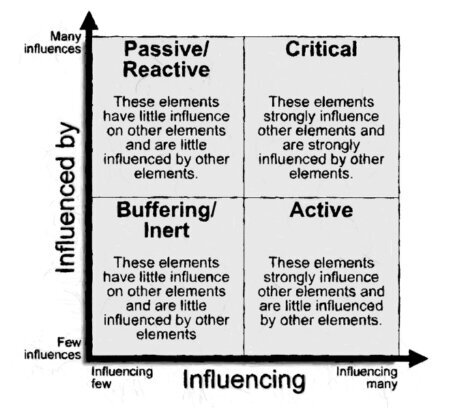
Passive (top left):
These elements influence a few other elements and, in turn, are not significantly influenced by them. Passive system elements are ideal indicators because they absorb impulses without affecting other people.
Critical (top right):
These elements strongly influence other elements and are strongly influenced by different elements. Critical system components are powerful levers that must be used with great care.
Buffering (bottom left):
These elements have little influence on other elements and are not significantly influenced by them. Buffering system components receive few impulses and have a delayed effect on others, if at all.
Active (bottom right):
These elements strongly influence one another, and in turn, have little to no influence on each other. Impulses have a wide-ranging effect.
Let’s look at the example Resistance. Our exemplary system components are positioned in the following diagram based on their relationships.
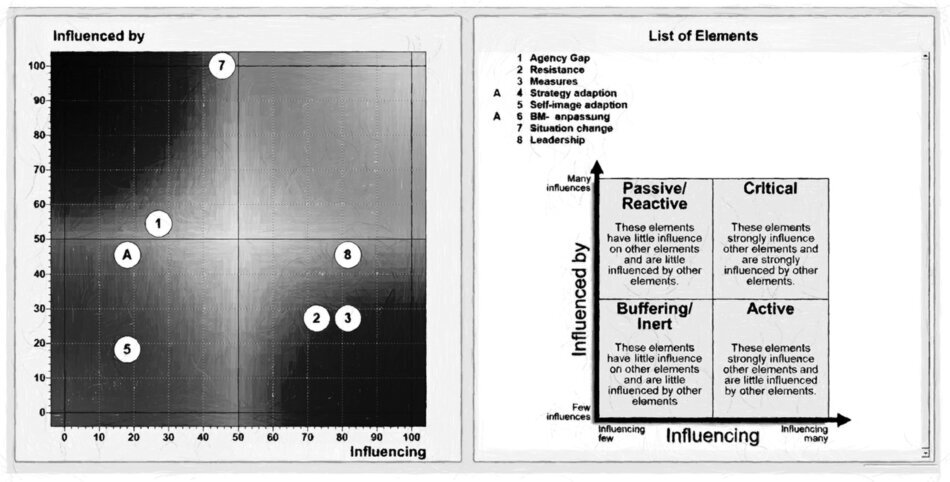
- Agency gap
Passive Archetype: little influence and medium influence.
The agency is challenged by changes in self-image, Business model, or strategy. Everyone is affected differently. As soon as the new situation does not match the self-image of the exec(utive/tors) and their interpretation of the role, an agency gap arises that creates stress.
Hack: Early recognition of emerging discrepancies caused by changes enables the implementation of timely countermeasures. - Resistance
Active Archetype: a lot of influence and little influence.
Resistance arises from not knowing, not being able to, not being allowed to, or not wanting to.
Hack: Since resistance is normal, understanding the individual reasons is crucial so that measures can be implemented to lower the barrier. - Measures
Active Archetype: a lot of influence and little influence.
Measures are publishing, training, allowing, and justifying.
Hack: Publications and events overcome not knowing; training measures impart the necessary skills; official authorization from those in charge eliminates the 'not being allowed'; personal questioning determines the reasons for the unwillingness. - Strategy adjustment
Buffering Archetype: little influence and medium influence.
The strategy comprises a Vision, Mission, Critical Success Factors, Value disciplines, SWOT, Strategic orientation, strategic goals, and Strategic core.
Hack: Ensure that the strategy is consistent and does not contain conflicting requirements so that exec(utives/utors) know what to do. Decision-making distress regarding which strategy elements everyone should follow must be avoided by regularly reviewing consistency. - Self-image adaptation
Buffering Archetype: little influence and little influence.
Self-image (identity) includes context, actions, skills, beliefs, roles, and affiliations.
Hack: Ensure that the self-image is consistent and does not contain conflicting requirements so that exec(utives/utors) know what to do. Decision-making distress caused by uncertainty about which elements of the self-image are valid should be resolved promptly through coordination. - Business model adjustment
Buffering Archetype: little influence and medium influence.
Changes to the business model include the Deliverables concept, Earning model, Value creation, partners, organization, customers, resources, communication, and coordination.
Hack: Ensure that the business model is consistent and does not contain conflicting requirements so that exec(utives/utors) know what to do. Decision-making distress caused by uncertainty about which elements of the business model apply should be resolved promptly through coordination. - Situation change
Active Archetype: a lot of influence and little influence.
Changes mainly result from self-image, business model, and strategy.
Hack: Ensure that the situational building blocks (strategy, self-image, and business model) fit together and do not pose conflicting requirements so that exec(utives/utors) know what to do. Decision-making distress should be proactively identified and resolved. - Leadership
Critical Archetype: medium influence and a lot of influence.
Leading primarily includes the following tasks of the exec(utives/utors): ensuring goals and transparency, organizing, deciding, controlling, developing, and promoting people, and is the task of leaders and managers.
Hack: Here, central control takes place. On the one hand, strategy is managed, the self-image is adjusted, and the business model is defined. On the other hand, the agency gap can be mitigated by being prepared for less threatening new liabilities, such as new roles or expanded self-organization.
The number of inputs and outputs determines the placement in the matrix. The evaluation result creates the system matrix. Further evaluations examine the course of effects, starting from a system component or tracing the causes or cycles that threaten or stabilize the system.
Recognize impulses
The system model is an effective way to identify
current and future situations and to find starting points that influence
circumstances with impulses. It should produce intended consequences and
prevent undesirable ones. Without an automatic pathway to the desired future,
we must anticipate scenarios and identify trigger points that steer the system
in the desired direction. The creativity of those involved is required to
identify patterns, solutions, and starting points that steer the system.
Through clever actuators – whether large or small, short- or long-term, direct
or indirect – the system gains momentum in a particular direction. Adaptable
starting points that correct undesirable system behaviors exist in the
environment and within the system.
The external starting points are political, economic, social, technological, and ecological influencing factors that have an impact in the respective context and can only be influenced to a limited extent through appropriate lobbying and communication. However, the interpretations can be aligned with your perspective. All impulses have a glocal effect.
- Political impulses originate from the environment of national institutions, such as the governmental system, policy, stability, economic zones, and political practices.
- Economic impulses result from various economic developments, including the economic system, cycles, structures, growth and contraction, inflation, taxes, interest rates, exchange rates, cost of living, labor rates, supplier networks, and other factors.
- Socio-cultural impulses are consequences of the social context, e.g., population structure and development, cultural values, norms, behavior, expectations, mobility, education, consumer behavior, and savings rates.
- Technological impulses arise from research and development, as well as the pervasion of the latest technologies, such as digital transformation, ICT infrastructure, public R&D expenditure, and basic technologies.
- Legal impulses are shaped by existing legal systems, including legislation, legal certainty, labor and competition law, product liability, and data protection.
- Ecological impulses can be observed in the local environment, including weather events, the availability of natural resources, environmental regulations, energy supply, and resource availability.
The internal starting points can be influenced
by oneself and are, in order of effectiveness, paradigms, strategy,
organization, governance, communication, and system structure. The greater the
impact, the more difficult it is to influence it. In any case, the commitment
of all those involved is crucial to their effectiveness.
- Paradigms are the profound principles that govern how the stakeholders’ world operates, such as business models, beliefs, culture, hierarchical and procedural structures, and governance.
- The strategy sets the direction and path for the future, encompassing Vision, Mission, Critical Success Factors, Value disciplines, SWOT analysis, alignment, overall objectives, Strategic core capabilities, as well as processes and services.
- The organization refers to the setup of the company, including its organizational form, distribution of tasks, and allocation of power.
- Governance is the "legal" framework of the company consisting of principles, business alignment, glossary, Critical Success Factors, metrics, guidelines, and roles.
- Communication encompasses the mutual flow of information, including channels, events, and everyday exchanges of information.
- The system structure defines the whole in terms of its delimitation from its environment, i.e., elements and relationships, resulting sequences and cycles, as well as other patterns.
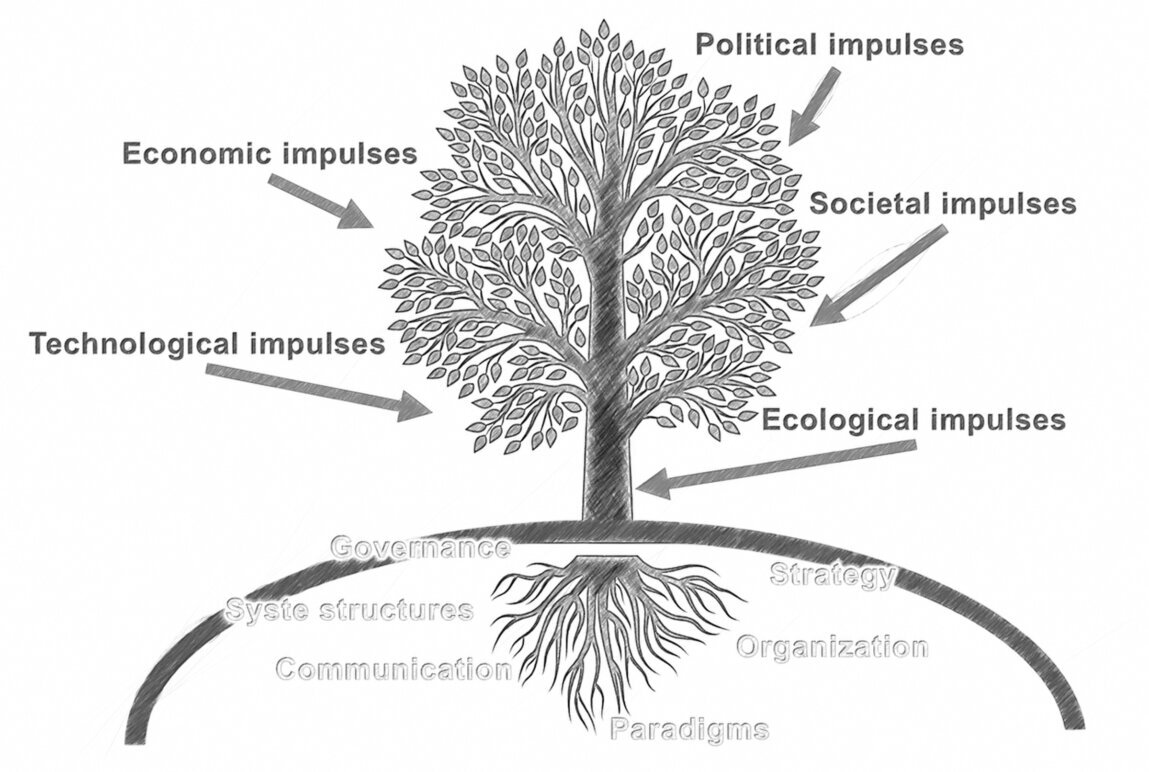
The impulses are determined by participants reviewing
the system descriptions and sharing their mental models. The following questions support the search
externally and internally.
- Which external impulses are relevant? Do we consider political influences everywhere? Which economic factors should we look at more closely? Do our activities fit into our social environment? Which technological advances are we not yet using? Are there any legal threats ahead? Are we prepared for ecological challenges? How can we influence or utilize external influence factors?
- What needs internal impulses? Where is the best place to start? Which paradigm strains our thoughts and actions? Are we still on the right track? Are we positioned effectively? Are our frameworks still relevant, and are we applying them accordingly? Are we exchanging our thoughts adequately? Are our system elements and relationships consistent? Which measures are most urgent?
Deriving the needs for action
The pressure to act arises from the necessity of
adopting immediate measures to remedy existing or foreseeable deficiencies,
risks, or potentials in a company, an economic sector, or an economy. The need
for action is created by internal or external changes that require adaptation
or innovation to ensure competitiveness, stability, growth, and viability. Compulsions arise at various levels of
action.
- Normative
This level encompasses fundamental issues related to the constitution, policy, and culture of the unit. - Strategic
This level includes the long-term orientation and overarching decisions regarding strategy, organization, and business model. - Tactical
The tactic includes a medium-term need for regulation, for example, to provide resources. - Operational
At this level, day-to-day operations necessitate immediate measures to prevent business malfunctions.
Collect the needs for action, bundle them by topics,
and transfer them to a ToDo outline.
Brainstorm ToDo sketch
For the final phase, Set up measures and draft the
ToDos as rough, short descriptions of the measures: What is the goal? What
premises must be considered? What results are expected?
The brainstorming session works best with the
following building blocks (adapted from Alex Osborn).
Brainstorming rules
The rules prevent the team from limiting themselves.
- Judicial judgement is ruled out
Anything that hinders the free flow of ideas is forbidden – e.g., criticism, judgments, killer phrases, and other negative statements.
- "Wildness" is welcomed
The more unusual the ideas, the more likely it is that new approaches will be found.
- Quantity is wanted
The goal is to find as many ideas as possible in the shortest possible time.
- Combining and improving is sought
It's not just necessary to introduce new ideas; it's essential. The identified ToDos can be improved and linked as desired.
Brainstorming Procedure
This process provides a reliable and consistent flow, allowing participants to
become increasingly skilled at brainstorming and focusing on the content.
- Present a meaningful problem specification
Brainstorming begins with a clear description of the problem. The perspectives of all participants are considered to ensure they understand the task and can contribute effectively.
- Set the rules
The rules for brainstorming (see above) are presented.
- Collect ideas
Participants write one note per idea. The collection is completed after at most 20 minutes or when no new ideas emerge.
- Bundle seven-plus-minus-two ideas
The slips of paper are divided and clustered by topic. Further ideas can be provided in the process.
The unstructured result is documented so that it can
be processed in the next phase.

